Mutale Kaunda is a pioneer on the subject of imbusa, a practice which is revered in Zambia and its diaspora. We are invited into divinity to contemplate a “school that takes root wherever a young woman is preparing for marriage” (16). The author offers a Bemba woman’s perspective on a knowledge system and its materiality and philosophical underpinnings.
Imbusa is a knowledge system which is constituted of social, political, and sexual ontologies, demonstrating a holistic world view and the transference of cultural norms. Imbusa are “sacred emblems / visual aids handed down to Bemba brides, before the wedding” (11). Beads, pottery, songs, proverbs, and rituals are teaching and learning modalities. Here, imbusa is presented as a site of negotiating and subverting Eurocentric and patriarchal norms which define personhood, sexuality, and cultural expression. Kaunda skillfully chronicles imbusa’s evolution from pre-, ante- to postcolonial periods and proposes a postcolonial curriculum.
Kaunda provides insight into the influence of colonialism on Bemba gender norms and women’s subjugation (109–10). A revelatory account is relayed of how colonial suppression began with the devaluation of Bemba spirituality. Kaunda recounts attempts to Christianize Babemba and imbusa. She critiques the colonial applications of Christianity, unpacking its enmeshment with Bemba cultural practices. Postcolonial imbusa demonstrates the feminist principle that the personal is political, detailing Bemba women’s spheres of power. She asserts that the private and public sphere weren’t demarcated before colonial and missionary imposition. With the spread of missionary enterprise, women became increasingly confined to the household. Missionaries promoted Victorian ideas of womanhood, emphasizing women’s roles as moral protectors and civilizers of the home and society. Imbusa is thus deliberated as a means through which women can, in Nzegwu’s terms “respond subversively to [these] … puritanical prescriptions.”
Imbusa has become confounded as some ‘colonized’ interpretations are passed down by older women (39). This is epitomized by the contemporary tendency to prioritize men’s well-being. Kaunda writes that the transmission of imbusa was tainted by colonial encounter and its patrilineal tendencies. Despite complexities, imbusa retains its power for women by affirming their sexual pleasure. While women undergo extensive training and report back to spouses along with their bana cimbusa (mentors), men are trained on pleasuring women in more informal settings. Kaunda demonstrates the intricacies of sex education proffered through imbusa and its role in affirming women’s “sexual agency” (41). Additionally, Kaunda links imbusa to broader Bemba conceptions of women’s bodies and reproductive rights, positing that women’s bodies are venerated, an exception in a continent where menstrual taboos prevail.
This book challenges the fixity which beleaguers studies of African communities, shedding light on Bemba culture in evolving contexts and on matrilineality in contemporary times (37). A methodological tour de force, this is a case study for nuanced ethnography. An “organic intellectual,” Kaunda recenters the role of Bemba women as knowledge producers. The author’s experiential knowledge is triangulated by interviews with seventeen “career women” in various “professional” fields and secondary sources. Kaunda poignantly illustrates the scholarly and sociopolitical value of devoting scholarly attention to women’s reproductive, sexual, and sociopolitical lives. The writer capably demonstrates what Nzegwu terms “robustness and resilience of the deeply rooted cultural practices.”
The choice to speak to middle-class and upper middle-class women is a useful delineation but there is need to unpack how these privileged women interact with women with less social mobility and access to resources. Women with less economic resources are less likely to eschew the structure, rituals, and obligations of imbusa. This calls into question the generalizability of the ideas put forward.
The claim to decoloniality is arguably contradicted by the definition of education and “formal” (9). This is further complicated by repeated references to educated women in terms of a hierarchy of in/formal knowledge (89). The class implications for such a delineation may have broader implications which weaken women’s solidarity and alienate disenfranchised women as well as older, less “formally” educated bana cinbusa.
The proposed curriculum is more dialogic and largely advantageous for women, suggesting the amplification of their voices. However, it overlooks the significance of semiotics and material culture. Removing the pottery component is an oversight, which undermines its social and semiotic value. Another aspect of Zambian life which is inadvertently undervalued is that of African spirituality. The author attempts to assert the value of indigenous spirituality but Christianized imbusa is still distinguished from a “raw, indigenous imbusa” (82). This statement is an unfortunate reprisal of Anglicized and Christianized accounts of African spirituality which visited Bemba communities at the onset of missionary and colonial enterprise. The claim to decoloniality is undermined by such statements which repeat Western tropes by borrowing from colonial discourse, which uses terms like “raw” to refer to nuanced and rich practices and the communities they are embedded in. Nonetheless, Kaunda exhibits how imbusa functions as a site of social reproduction whilst reflecting the wider control women have over reproduction, lineage, economy, religion, and politics.
This publication invites readers into the inner lives of Bemba women, reflecting their sociopolitical and economic power. The agentic power of imbusa and the co-option of women in white supremacist capitalist patriarchy is also deliberated. The author fastidiously demonstrates how “imbusa is a ubiquitous rite and is resilient and salient” (2).


